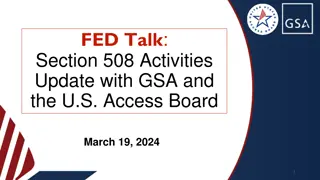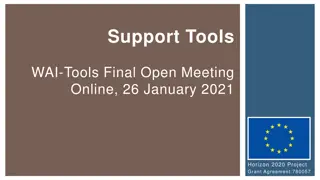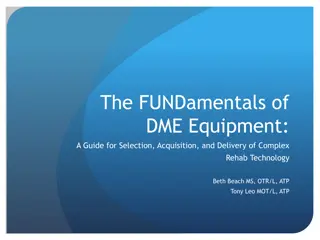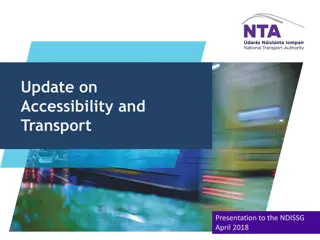2021 DME Manual Update Overview: Accessibility and Mobility Supports
This update provides an overview of revisions to the DME program benefitting accessibility and mobility supports. Changes include expanded coverage for medical car seats, portable ramps, and wheelchair tiedowns to enhance individuals' access to their home and community. Medical car seats for individuals with special orthopedic or medical needs are now covered with prior authorization. The updates aim to improve assistance for diagnosed conditions and functional limitations, extending beyond traditional in-home use requirements.
Download Presentation

Please find below an Image/Link to download the presentation.
The content on the website is provided AS IS for your information and personal use only. It may not be sold, licensed, or shared on other websites without obtaining consent from the author.If you encounter any issues during the download, it is possible that the publisher has removed the file from their server.
You are allowed to download the files provided on this website for personal or commercial use, subject to the condition that they are used lawfully. All files are the property of their respective owners.
The content on the website is provided AS IS for your information and personal use only. It may not be sold, licensed, or shared on other websites without obtaining consent from the author.
E N D
Presentation Transcript
2021 DURABLE MEDICAL EQUIPMENT (DME) MANUAL UPDATE OVERVIEW This update provides an overview of manual revisions related to the DME program benefits specifically to accessibilityand mobility supports Division for Aging and Disability Services
Agenda Updates include CMS mandated change to the DME definition Additional coverage added Medical car seats Portable ramps Wheelchair tiedowns (also know as transit option) Implications for waivers and EPSDT 2 Division for Aging and Disability Services
DME Definition Change Suitable for use, and consistent with 42 CFR 440.70(b)(3), that treats a diagnosed condition or assists the individual with functional limitations. DME no longer has to be primarily used in the home. DME can be for any place normal life activities take place. (exceptions include: individuals in the hospital, nursing facilities and ICF/IID) Based on this definition change DMAS is adding coverage for Medical car seats, Wheelchair tiedowns, and portable ramps. The goal of the definition change is to allow individuals greater access to their home and community. Division for Aging and Disability Services 3
Medical Car Seats Medical Car seats for use in vehicles may be covered with prior authorization for individuals with special orthopedic or medical needs related to positioning that cannot be met using conventional car seats or with needs that make conventional car seats medically inappropriate. A positioning seat may be medically necessary for a recipient with an inability to maintain an unsupported sitting position independently which is caused by a medical condition such as the following (list is not all-inclusive): Division for Aging and Disability Services 4
Medical Car Seats Cont. Severe head and trunk instability Severe hypotonicity, hypertonicity, spasticity or muscle spasms which result in uncontrollable movement and position changes Severe seizure activity that results in uncontrollable movement and position changes Orthopedic disease processes resulting in significant bony fragility Significant contractures that would result in an inability to perform postural corrections due to vehicle motion Orthopedic condition, such as a curvature of the spine, which interferes with proper positioning; and The individual must be within the manufacturer guidelines for height and weight. Division for Aging and Disability Services 5
Medical Car Seats - Cont.. Documentation for the authorization request for a positioning seat for use in vehicles must include: Evaluation by a physical therapist or occupational therapist, Description of the medical condition that causes the need for the positioning seat, Description of other interventions that have been tried to meet the recipient s needs, and Description of less costly positioning seats that have been considered and rejected. Document the recipient s current height and weight, and the weight capacity and growth potential for the requested seat. Division for Aging and Disability Services 6
Wheelchair Tiedowns (Transit option) Tiedowns, also known as, transit options and transport brackets are required for individuals and their wheeled mobility to be safely transported in a vehicle with the community. Tiedowns may be covered if the following are met: The wheelchair or stroller has passed ANSI/RESNA WC19 or ISO 7176-19. The wheelchair needs to be effectively secured to the vehicle using a 4 point strap-type tiedown or docking system that complies with SAE J2249 or ISO 10542 Tiedowns reduce the potential for injury while the individual or equipment is being transported in a vehicle or public transportation. Tiedowns may be covered for wheelchairs and strollers, occupied or unoccupied. Prior authorization will be required for tie downs and documentation must include a statement from a physical or occupational therapist that include the medical need for the tiedowns to be used in conjunction with the mobility device and if the wheelchair will be occupied or unoccupied during transport. Documentation must also include an attestation by the provider that the wheelchair meets the above criteria. Easy lock systems for conversion vans are not covered. Division for Aging and Disability Services 7
Wheelchair Tiedowns - references ANSI/RESNA,ANSI/RESNA WC19: Wheelchairs Used as Seats in Motor Vehicles. 2000, American National Standards Institute (ANSI)/Rehabilitation Engineering and Assistive Technology Society of North America (RESNA). ISO,ISO 7176/19: Wheelchairs Used as Seats in Motor Vehicles. 2000, International Organization for Standardization: Geneva, Switzerland. Society of Automotive Engineers,SAE J2249: Wheelchair Tiedowns and Occupant Restraint Systems - Surface Vehicle Recommended Practice. 1999, Society of Automotive Engineers: Warrendale, PA. ISO,ISO 10542-2: Technical systems and aids for disabled or handicapped persons - Wheelchair tiedown and occupant-restraint systems - Part 2: Four point strap type tiedown systems. 1999, International Organization for Standardization: Geneva, Switzerland. ISO,ISO 10542-3: Technical systems and aids for disabled or handicapped persons - Wheelchair tiedown and occupant-restraint systems - Part:3: Docking type tiedown systems. 2005, International Organization for Standardization: Geneva, Switzerland. Division for Aging and Disability Services 8
Portable Ramps Portable ramps are placed over inclines, steps, and other uneven surfaces to provide passage for individuals who use assistive mobility devices. A portable ramp may be covered for an individual with an order from a practitioner when it is required to support transfer and performance of activities of daily living in the home and community. Prior authorization is required Division for Aging and Disability Services 9
Portable Ramps Cont. Two types of portable ramps may be covered, portable ramps and threshold ramps, with prior authorization and an evaluation from physical therapist, occupational therapist or certified Assistive Technology Professional (ATP) that must document the medical need for the ramp. 1. Portable ramps For use in the home or for vehicle transportation. Typically constructed of metal or fiberglass. 2. Removable threshold ramps For use in the home to cross over interior or exterior thresholds. Must be removable (not permanently affixed). Typically constructed of rubber or aluminum. Division for Aging and Disability Services 10
Portable ramps Cont.. Portable ramp Removable Threshold Ramp 11
Portable Ramps - Cont Portable ramps will not be covered if the individual already has a permanent ramp at their residence or their vehicle is already wheelchair accessible. Permanent and modular ramps are not covered under the DME benefit. Permanent ramps vs. portable ramps will be discussed on the next slide Division for Aging and Disability Services 12
Implications cont Portable Ramps vs Permanent Ramps Not every member who may require a portable ramp is enrolled in one of the waiver programs. A permanentramp is usually preferred by most members, however, we understand that for most of our members, especiallythose who are not enrolled in the CCC plus waiver or the DD Waivers, that a permanentramp is not always an available option. If a member already has a permanent ramp installed at the home then a portable ramp may not be covered unless it is used for another reason like for vehicle use. For example, if the family transports their child or adult in a van but the van does not have a wheelchair ramp or lift, the portable ramp would be used to get the wheelchair into the vehicle (for a powered mobility device). Power wheelchairs are extremely heavy and can't be lifted into the vehicle in most cases. In this case, it would be appropriate to cover the portable ramp even though the member has a permanent ramp on the home. Another example would be the use of a threshold ramp. If a permanent threshold ramp is available to the individual,this may be the preferred means of coverage if the member is enrolled in a waiver. However, for the member not enrolled in a waiver this is not an option. One portable threshold ramp could be covered to allow the member to access uneven or higher (non-flat) thresholds within their home or community setting. This will be individual specific, as every member has different circumstances and those should be taken into consideration. It would be impossible for us to cover every circumstance in the manual. Division for Aging and Disability Services 13
Implications for Waiver Services and EPSDT Prior to implementation of the DME definition change portable ramps, wheelchair tiedowns and medical car seats were only covered under EPSDT or through the EM/AT benefit available in the CCC Plus or DD waivers. This change will add coverage to the DME benefit for these items and also ends the age restriction for these items. However, it is important to note that for medical car seats there are restrictions for weight and height. All requests must be submitted through the DME benefit using the appropriate HCPCS code. If criteria are not met, the request is then reviewed under EPSDT for children under the age of 21. Requests submitted for these items through EPSDT or the CCC Plus waiver (T1999 or T5999) prior to DME should be rejected and the provider notified to resubmit through DME using the appropriate code(s) T5001 for Medical Car Seats E1399 for Portable ramps K0108 for Wheelchair Tiedowns Division for Aging and Disability Services 14
Implications Cont. CMS mandated the DME definition change to allow greater access to the individual's community. It is not a duplicate service to allow a medical car seat and wheelchairtiedowns. Depending on the type of wheelchair/stroller/scooter the individualuses for mobility it may not be rated for vehicle travel with an occupant. Or the individual may need the medical car seat for additional support during travel. However, because the individual will need the wheelchair for mobilityonce they arrive at their destination, for community use, then it is imperative that the wheelchair be available for use once they arrive. It is important that these items be properly transported to prevent injury in the case of an accident. DMAS does not consider this a duplication of services if wheeled mobility is needed at the individual's destination. Division for Aging and Disability Services 15
Implications Cont While DMAS does not cover DME furnished for the safety or restraint of the individual, or solely for the convenience of the family, attending practitioner, or other practitioner or supplier. Exceptions for safety equipment may be made for medical car seats, wheelchair tiedowns, positioning devices or safety belts/harness for transportation. Division for Aging and Disability Services 16
Additional Updates Please Make Sure To Review The Entire Manual Providers and all employees are responsible for reading and adhering to the DMAS policies and regulations. The provider must also insure that all requirements for services are met in order to receive payment from DMAS. Note: It is important for care coordinators, case managers at DBHDS and anyone who deals with waiver individuals to understand these changes and to make sure they are familiar with what is covered under DME and what items would fall to waiver or EPSDT coverage. Division for Aging and Disability Services 17
Go Live This update has a go live date in July 1, 2021. Make sure to download updated copies of the DME manual from the portal. 18
Contacts Contacts: For CCC Plus and Medallion 4 - Next slide DD/ID waiver sam.pinero@dbhds.virginia.gov For FFS Contact DMAS via dme@dmas.virginia.gov Service authorization - paur06@dmas.virginia.gov KePRO - 888-827-2884 Division for Aging and Disability Services 19
Contacts Magellan - Kim Harshman harshmank@magellanhealth.com and Heather McNeil mcneilh@magellanhealth.com for both CCC plus and Medallion 4. United Health Care - Our Provider Service Contact Center will be the primary point of contact for inquiries. The Medallion Provider Call Center number is 844-284-0146, and CCC Plus Provider Call Center 877-843-4366. Par providers are assigned advocates and should reach directly out to them. If the provider is unsure of their advocate or is non-PAR they may contact the mailbox HCBS_northeast_pr@uhc.com. Aetna - R.J. Dix, Manager Provider Relations Aetnabetterhealth-VAProviderRelations@aetna.com Anthem Bernard Christmas, Provider Relations Manager Bernard.Christmas@Anthem.com Taylor Rhodes, Provider Relations Director William.rhodes@Anthem.com VA Premier - Robin Murray, Network Relations Manager Virginia Premier Health Plan 276.619.0963 x55626 Robin.Murray@VirginiaPremier.com Optima - Deborah Abbey-Bada, Network Relations Manager email: mdabbeyb@sentara.com Office: 757- 983-9671 20
Questions Thank you for joining us today!! 21























